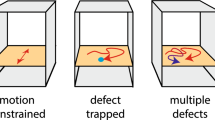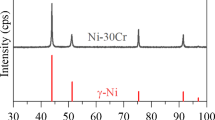Abstract
A numerical model to treat the kinetics of vacancy annihilation at the metal/oxide interface but also in the bulk metal has been implemented. This was done using EKINOX, which is a mesoscopic scale 1D-code that simulates oxide growth kinetics with explicit calculation of vacancy fluxes. Calculations were performed for high temperature Ni–Cr alloys oxidation forming a single chromia scale. The kinetic parameters used to describe the diffusion in the alloy were directly derived from an atomistic model. Our results showed that the Cr depletion profile can be strongly affected by the cold work state of the alloy. In fact, the oversaturation of vacancies is directly linked to the efficiency of the sinks which is proportional to the density of dislocations. The resulting vacancy profile highlights a supersaturation of vacancy within the metal. Based on the classical nucleation theory, the possibility and the rate of void formation are discussed.






Similar content being viewed by others
References
P. Berthod, Oxidation of Metals 64, 2005 (235).
E. Y. Shida, G. C. Wood, F. H. Stott, D. P. Whittle and B. D. Bastow, Corrosion Science 21, 1981 (581).
A. H. Rosenstein, J. K. Tien and W. D. Nix, Metallurgical Transactions A 17A, 1986 (151).
J. H. Weber and P. S. Gilman, Scripta Metallurgica 18, 1984 (479).
C. D. L. Douglass, Corrosion Science 8, 1968 (665).
R. Hales and C. Hill, Corrosion Science 12, 1972 (843).
E. Aublant, O. Calonne, and M. Foucault, PTCMC-F R 11 0020 internal AREVA report.
D. J. Young, High Temperature Oxidation and Corrosion of Metals, (Elsevier, Amsterdam, 2008).
D. Oquab and D. Monceau, Scripta Metallurgica 44, 2001 (2741).
B. Gleeson, W. Wang, S. Hayashi and D. Sordelet, Material Science Forum 461–464, 2004 (213).
Y. Cadoret, D. Monceau, M.-P. Bacos, P. Josso, P. Marcus and V. Maurice, Oxidation of Metals 64, 2005 (185).
H. E. Evans, Materials Science and Technology 4, 1988 (1089).
B. Pieraggi, R. A. Rapp and J. P. Hirth, Oxidation of Metals 44, 1995 (63).
R. Francis and D. G. Lees, Materials Science and Engineering 120, 1989 (97).
S. Perusin, B. Viguier, D. Monceau, L. Ressier and E. Andrieu, Acta Materiala 52, 2004 (5375).
H. B. Huntington and F. Seitz, Physical Review 61, 1942 (315).
E. O. Kirkendall, Transaction the Metallurgical Society of AIME 147, 1942 (104).
L. Martinelli, F. Balbaud-Célérier, A. Terlain, S. Bosonnet, G. Picard and G. Santarini, Corrosion Science 50, 2008 (2537).
F. Gesmundo and P. Y. Hou, Oxidation of Metals 59, 2003 (63).
M. Bobeth, M. Gutkin, W. Pompe and A. E. Romanov, Physica Status Solidi A 165, 1998 (165).
S. Dryepondt, Y. Zhang and B. A. Pint, Surface and Coating Technology 201, 2006 (3880).
C. Desgranges, N. Bertrand, K. Abbas, D. Monceau and D. Poquillon, Material Science Forum 461–464, 2004 (481).
N. Bertrand, C. Desgranges, M. Nastar, G. Girardin, D. Poquillon and D. Monceau, Material Science Forum 595–598, 2008 (463).
P. Kofstad, Oxidation of Metals 44, 1995 (3).
V. Barbe and M. Nastar, TMS Letters, Vol. 2 (TMS, The Minerals, Metals and Materials Society, Warrendale, 2005), p 93.
C. S. Giggins and F. S. Pettit, Transactions of the Metallurgical Society of AIME 245, 1969 (2495).
Acknowledgments
F. Delabrouille (EDF) for providing model alloys, P. Poisson and L. Guérin (AREVA) for SEM observations are gratefully acknowledged.
Author information
Authors and Affiliations
Corresponding author
Rights and permissions
About this article
Cite this article
Desgranges, C., Lequien, F., Aublant, E. et al. Depletion and Voids Formation in the Substrate During High Temperature Oxidation of Ni–Cr Alloys. Oxid Met 79, 93–105 (2013). https://doi.org/10.1007/s11085-012-9328-0
Received:
Published:
Issue Date:
DOI: https://doi.org/10.1007/s11085-012-9328-0




